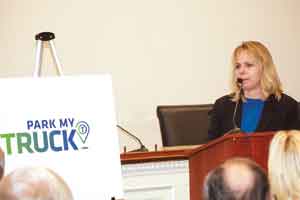Industry Groups Unite to Develop New App Aimed at Making Truck Parking Easier to Find

This story appears in the May 23 print edition of Transport Topics.
WASHINGTON — Industry groups announced they will launch a free truck parking smartphone app in August, joining several from the private sector already in place.
Natso President Lisa Mullings said truckers will be able to download data updated every two hours by commercial truck stops that will enable them to find available parking at truck stops and state-provided rest areas in the 48 continental states.
“Professional drivers are essential to our economy and our way of life in America,” said Mullings, whose group represents truck stops and is partnering on Park My Truck with American Trucking Associations, the American Transportation Research Institute and the Commercial Vehicle Safety Alliance. “Their safety and security are a major priority.”
The Natso Foundation is paying to develop the app, which will compete with versions from the private sector such as Trucker Path. During an interview with Transport Topics last week, CEO Ivan Tsybaev said Trucker Path provides real-time data from truckers and claims 450,000 active users.
“Trucker Path is ready to work with anyone who is as passionate as us about making truckers’ jobs easier, more beneficial and fun,” said Tsybaev, who founded the company in 2013. “We’re very excited to make the industry more efficient. I’m sure we’ll find the way to work with the Park My Truck initiative. We’re currently in conversation with the key stakeholders. The truck parking problem is very serious. However, with the right tool, truckers can always find the available truck parking.”
ATA President Bill Graves said the hunt for parking spaces causes “sheer frustration” for drivers, and he called Park My Truck “an important step in the right direction” for their safety.
Truck parking was No. 5 on ATRI’s annual list of critical industry issues in 2015, In a survey released by the Federal Highway Administration last year, most states reported truck parking shortages. More than three-fourths of drivers reported frequent problems with finding safe parking locations when they needed to rest.
Graves also noted that many more trucks are expected to be on the road as the economy expands and the population grows during the coming years. According to FHWA, the amount of freight moving in the United States will grow by 45% by 2040.
Making parking easier to find also will help keep drivers from cutting their shifts short to avoid violating federal hours-of-service rules.
“The utilization of the equipment is precious,” Graves said. “The fuel they’re burning is precious. Getting the cargo safely to and from wherever it’s supposed to be going is precious. Being able to more efficiently find parking is an important contributor to a more efficient supply chain.”
Jason Rivenburg, the driver whose murder in 2009 at an abandoned South Carolina gas station inspired “Jason’s Law,” was a constituent of Rep. Paul Tonko (R-N.Y.).
“Access to safe and accessible rest stops can be a life-or-death issue as I unfortunately learned during my first term in office,” Tonko said. “Truckers deserve safety, nothing less.”
Several other representatives appeared at the kickoff press conference for the app.
“This technology will help us [keep trucks] from parking on the side of an interstate or a ramp,” said Rep. Bill Shuster (R-Pa.), chairman of the House Transportation and Infrastructure Committee.
Del. Eleanor Holmes Norton (D-D.C.) termed Park My Truck “a perfect example of a public- private partnership because [the federal government] had to pay for the study [identifying the problem].”

